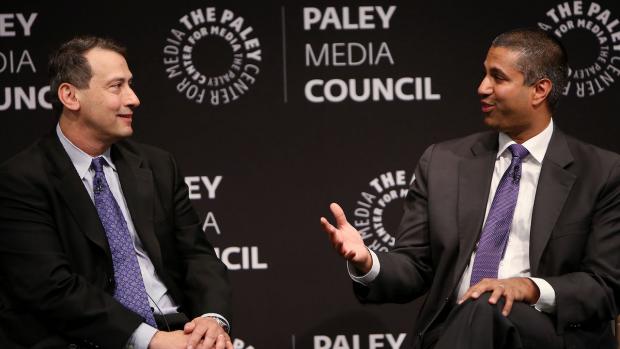Ted Rappaport and FCC Chairman Ajit Pai talk 5G and more at Paley Center event

Professor of Electrical Engineering and founding director of NYU WIRELESS, Ted Rappaport with FCC Chairman Ajit Pai. (Image provided by The Paley Center for Media)
Just a day after the 85th birthday of the U.S. Federal Communications Commission (FCC), Theodore (Ted) Rappaport, founding director of NYU WIRELESS, and FCC Chairman Ajit Pai shared the stage for a wide-ranging conversation about Pai’s efforts to advance 5G wireless, update the regulatory landscape, and bridge the digital divide between rural and urban America.
At the invitation-only event on Thursday, June 20, at the prestigious Paley Center for Media in New York, the two spoke before a packed room of journalists and corporate leaders who were eager to learn more about the chairman’s thoughts at this important time in the history of communications.
At the prompting of Rappaport, who is also the David Lee/Ernst Weber Professor of Electrical Engineering at NYU Tandon, Pai spoke about how his experience growing up in rural Kansas as a first-generation immigrant informs his work, including his ambition to bring the kind of broadband connectivity that urban centers already enjoy to American small towns.
He lauded Rappaport not only for his role in advancing wireless communications — including serving as a positive force in recent FCC decisions to allocate new spectrum above 95 GHz — but also for his far-ranging research that has helped shape the industry, while joking that Rappaport has forgotten more in his time than Pai has learned in his. Rappaport was recently invited to serve on the FCC’s Technological Advisory Council (TAC), which has convened a new two-year term.
When Rappaport queried Pai about how the FCC is adapting the regulatory landscape to fast-moving changes in telecommunications, including the proliferation of media channels and devices, Pai offered a nod to Yoda of Star Wars fame, who, in the iconic film, instructs Luke Skywalker to “…unlearn what you have learned”: he pointed out that many regulations on the books are holdovers from the broadcast era, citing an especially stodgy rule in effect until recently that required TV stations to keep hard copies of FCC regulations on hand. The goal, he said, was to start from scratch and shape regulations based on what’s happening in the landscape today.
A pertinent example is that low-power small-cells until recently fell under the same rules as tall, high-power earlier generation cell towers, hindering the kind of high-density deployment necessary for 5G rollout. The FCC, he said, has updated regulations to put small units in a different regulatory framework from larger cell towers.
Rappaport mulled aloud whether a broader challenge might be regulating industry consolidation without squelching game-changing innovations that corporate funding makes possible.
Pai responded that the litmus test is whether, ultimately, a given merger or move toward corporate expansion through acquisition is in the public interest and whether it is, in essence, pro- or anti-competitive.
Both agreed on the importance of closing the digital divide by finding ways to deliver broadband to rural areas of the United States — NYU WIRELESS’ own research laid the groundwork by proving the virtues of fixed millimeter-wave wireless technologies.
Pai called fixed wireless a “hidden gem” to deliver 5G beyond cities and suburbs, a potential boon whose benefits extend beyond faster video downloads to telemedicine applications, from wireless sensors for medical monitoring to e-consultations on mental health and autism, for example, in areas where such services aren’t currently available. “5G could be transformative for rural America,” he said. “Telemedicine is just the tip of the spear.”




